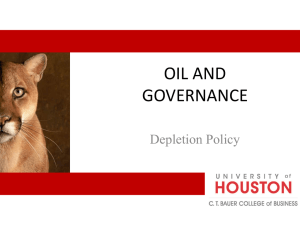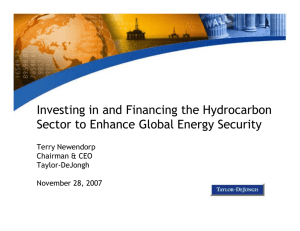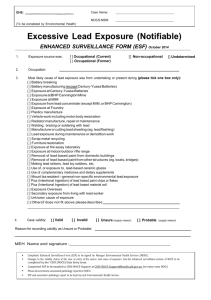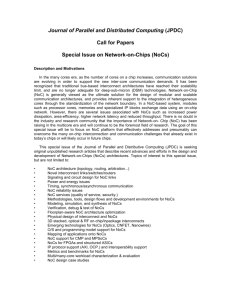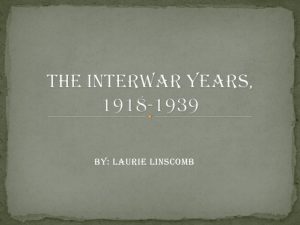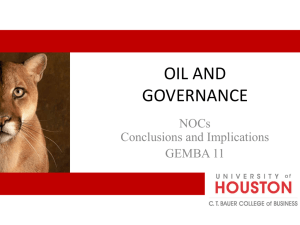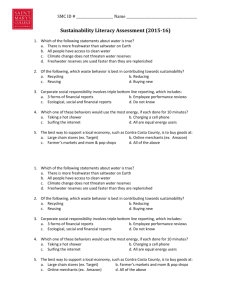joint ventures bargaining and vertical integration
advertisement
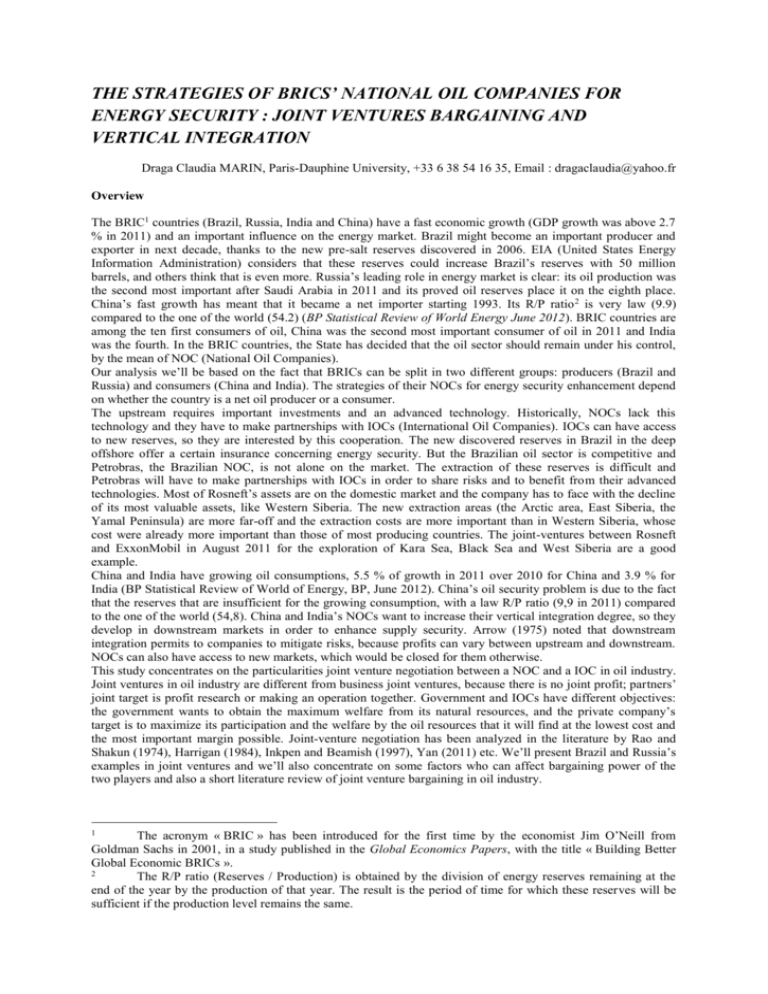
THE STRATEGIES OF BRICS’ NATIONAL OIL COMPANIES FOR ENERGY SECURITY : JOINT VENTURES BARGAINING AND VERTICAL INTEGRATION Draga Claudia MARIN, Paris-Dauphine University, +33 6 38 54 16 35, Email : dragaclaudia@yahoo.fr Overview The BRIC1 countries (Brazil, Russia, India and China) have a fast economic growth (GDP growth was above 2.7 % in 2011) and an important influence on the energy market. Brazil might become an important producer and exporter in next decade, thanks to the new pre-salt reserves discovered in 2006. EIA (United States Energy Information Administration) considers that these reserves could increase Brazil’s reserves with 50 million barrels, and others think that is even more. Russia’s leading role in energy market is clear: its oil production was the second most important after Saudi Arabia in 2011 and its proved oil reserves place it on the eighth place. China’s fast growth has meant that it became a net importer starting 1993. Its R/P ratio 2 is very law (9.9) compared to the one of the world (54.2) (BP Statistical Review of World Energy June 2012). BRIC countries are among the ten first consumers of oil, China was the second most important consumer of oil in 2011 and India was the fourth. In the BRIC countries, the State has decided that the oil sector should remain under his control, by the mean of NOC (National Oil Companies). Our analysis we’ll be based on the fact that BRICs can be split in two different groups: producers (Brazil and Russia) and consumers (China and India). The strategies of their NOCs for energy security enhancement depend on whether the country is a net oil producer or a consumer. The upstream requires important investments and an advanced technology. Historically, NOCs lack this technology and they have to make partnerships with IOCs (International Oil Companies). IOCs can have access to new reserves, so they are interested by this cooperation. The new discovered reserves in Brazil in the deep offshore offer a certain insurance concerning energy security. But the Brazilian oil sector is competitive and Petrobras, the Brazilian NOC, is not alone on the market. The extraction of these reserves is difficult and Petrobras will have to make partnerships with IOCs in order to share risks and to benefit from their advanced technologies. Most of Rosneft’s assets are on the domestic market and the company has to face with the decline of its most valuable assets, like Western Siberia. The new extraction areas (the Arctic area, East Siberia, the Yamal Peninsula) are more far-off and the extraction costs are more important than in Western Siberia, whose cost were already more important than those of most producing countries. The joint-ventures between Rosneft and ExxonMobil in August 2011 for the exploration of Kara Sea, Black Sea and West Siberia are a good example. China and India have growing oil consumptions, 5.5 % of growth in 2011 over 2010 for China and 3.9 % for India (BP Statistical Review of World of Energy, BP, June 2012). China’s oil security problem is due to the fact that the reserves that are insufficient for the growing consumption, with a law R/P ratio (9,9 in 2011) compared to the one of the world (54,8). China and India’s NOCs want to increase their vertical integration degree, so they develop in downstream markets in order to enhance supply security. Arrow (1975) noted that downstream integration permits to companies to mitigate risks, because profits can vary between upstream and downstream. NOCs can also have access to new markets, which would be closed for them otherwise. This study concentrates on the particularities joint venture negotiation between a NOC and a IOC in oil industry. Joint ventures in oil industry are different from business joint ventures, because there is no joint profit; partners’ joint target is profit research or making an operation together. Government and IOCs have different objectives: the government wants to obtain the maximum welfare from its natural resources, and the private company’s target is to maximize its participation and the welfare by the oil resources that it will find at the lowest cost and the most important margin possible. Joint-venture negotiation has been analyzed in the literature by Rao and Shakun (1974), Harrigan (1984), Inkpen and Beamish (1997), Yan (2011) etc. We’ll present Brazil and Russia’s examples in joint ventures and we’ll also concentrate on some factors who can affect bargaining power of the two players and also a short literature review of joint venture bargaining in oil industry. The acronym « BRIC » has been introduced for the first time by the economist Jim O’Neill from Goldman Sachs in 2001, in a study published in the Global Economics Papers, with the title « Building Better Global Economic BRICs ». 2 The R/P ratio (Reserves / Production) is obtained by the division of energy reserves remaining at the end of the year by the production of that year. The result is the period of time for which these reserves will be sufficient if the production level remains the same. 1 For China and India, we’ll going to concentrate on the impact of vertical integration strategy of their NOCs on countries’ supply security. There is a certain number of studies that were made concerning vertical integration, but NOC literature is limited. This is the reason why World Bank started in 2008 a study concerning NOCs and value creation. So, NOCs role in supply security has been few studied, some documents like the CRS Report for Congress3 mention it. Methods In this study, we’ll use econometric technique in order to show the influence of vertical integration degree on supply security for China and India. We’ll employ Arkel, Boots and Jansen’s4 report in order to create several indicators for long termed supply security measurement: the diversity index, the diversity of supply regions, the diversity of supply regions and socio-politic stability and the resources depletion. We’ll create an index for oil supply security, as the average of these four indicators. Vertical integration will be measured by the different dimensions identified by Harrigan (1986): the degree, the number of stages of processing, the breadth of activities and the ownership form. We use a regression model to show the relationship between oil supply security and vertical integration. Results The econometric model couldn’t be run, because data for some periods are difficult to be found for China and India. The model is only in a conceptual form for now. Conclusions As per Van der Linde (2000) emphasizes, the desire to ensure supply and demand security has sustained the vertical integration and the internalization of oil companies since the beginning of the modern oil industry. Even if upstream is the main focus of NOCs from China’s and India’s investments abroad, building refineries and pipelines can contribute to the reinforcement of their relationships with the host countries. The notion of reserves is an economic one, oil reserves will increase with the prices growth. But more technical and human capital will be needed, because the oilfields that will be explored need advanced technology and experience. IOCs have access to the up-to-date technology, which is less easily available for NOCs. So partnerships between oil producing countries NOCs, like Russia and Brazil, should develop in the future. References Van Arkel, W.G. and M.G. Boots, J.C Jansen. Designing indicators of long-term energy supply security. Energy Research Centre of the Netherlands ECN, 2004. Arrow, Kenneth J. « Vertical integration and communication. » Bell Journal of Economics 6, n° 1 (1975) : 173183. http://www.jstor.org/stable/3003220. Beamish, Paul W. et Andrew C. Inkpen. « Knowledge bargaining power and the instability of international joint ventures. » Academy of Management Review 22, n° 1 (1997) : 177-202. Harrigan, Kathryn. « Matching vertical integration strategies to competitive conditions. » Strategic Management Journal 7, n°6 (1986) : 535-555. Harrigan, Kathryn Rudie. « Joint venture and global strategies. » Columbia Journal of World Business (1984) : 7-16. Pirog, Robert. The role of National oil Companies in the International Oil Market. CRS Report for Congress. 2007. Rao, Ambar G. et Melvin F. Shakun. «A normative model for negotiations. » Management science 20, n° 10 (1974) : 1364-1375. Van der Linde, Coby. The State and the International Oil Market. Competition and the changing ownership of cude oil assets. Studies in industrial organization. Boston : Kluwer Academic Publishers, 2000. Yan, Min-Rei. « A fuzzy logic enhanced bargaining model for business pricing decision support on joint venture projects. » Journal of Business Economics and Management 12, n° 2 (2011) : 234-247. 3 Robert Pirog. The role of National oil Companies in the International Oil Market. CRS Report for Congress. 2007. W.G. Van Arkel and M.G. Boots, J.C Jansen. Designing indicators of long-term energy supply security. Energy Research Centre of the Netherlands ECN, 2004. 4
